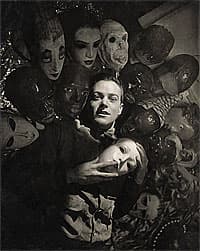Oliver MESSEL

Oliver Hilary Sambourne Messel (b London, 13 January 1904 – d Barbados, 13 July 1978) studied painting at Slade School of Fine Art in London from 1922–24. There he began making masks and in 1925 some of these where shown in the Claridge Gallery exhibition Character masks. Both Diaghilev and the English impresario Sir Charles Blake Cochran saw this exhibition and Diaghilev commissioned Messel to create masks and symbols for the Ballets Russes’ London production of Zéphire et Flore (1925).
Messel continued to work for Cochran, producing masks for his annual revues at the London Pavilion in the late 1920s. He produced set and costume designs for Cochran’s production of the opera-bouffe Helen (1926) and The miracle (1932). In 1937 he was commissioned by the Ballets Russes de Monte Carlo to produce designs for its ballet, Francesca da Rimini, at Covent Garden, London.
From 1932, while continuing to design for the theatre and ballet, he branched out into film, designing sets and costumes for the MGM film version of Shakespeare’s Romeo and Juliet (1936). In 1944 he began work on Caesar and Cleopatra (1945), on which he was costume designer, art director and uncredited as the jewellery designer. In 1960 he was nominated for Best Art Direction-Set Decoration Oscar for his work on Suddenly, last summer (1959). He also designed for many Broadway productions in New York, collecting numerous Tony Award nominations and winning the Best Scenic Design award in 1955 for House of flowers.
George Hoyningen-Huene
Costume designer Oliver Messel with theatrical masks c 1929 Condé Nast collection, © Condé Nast Archive/CORBIS




